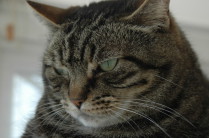History
The British Shorthair is native to Great Britain in the same way that the American Shorthair is native to America, long ago he was transported there from somewhere else. However, the progenitor of the Brit is probably Great Britain's oldest natural breed of cat, and was roaming around Great Britain for centuries before his cousin journeyed to the New World.
The Brit's progenitor was a common street cat once called the European Shorthair. This breed (whose conformation is much different from the Brits you'll see in show halls today) came to Great Britain some 2,000 years ago, courtesy of the Roman Empire. The Romans, who kept cats as pets and for rodent control, transported this shorthaired breed to northern Europe and eventually to their outlying provinces in the British Isles.
For centuries, this rugged cat hung out in Great Britain's alleys and barns. In the late 1800s cat fancier Harrison Weir, well known for his contributions to the emerging cat fancy, was instrumental in establishing the British Shorthair as an officially recognized breed. Through his efforts, British Shorthairs were featured in England's first cat show at the Crystal Palace of London, and quickly became popular with the British cat fancy.
Just before the turn of the century, longhaired exotics caught the cat fancy's eye and British Shorthairs declined in popularity. Nevertheless, Brits held their own until the chaos of World War II decimated the breed (along with many other European breeds as well).
After the war, breeders dedicated to preserving the British Shorthair gained permission from the British Governing Council of the Cat Fancy to interbreed their Brits with other cat breeds to rebuild the gene pool. Persians were bred into the existing bloodlines, and shorthaired breeds such as the Chartreux were also added. These efforts transformed the Brit into its current form: a large, powerful mini-teddy bear with a full, round face and a placid disposition.
American cat fanciers took little notice of the British Shorthair until the 1960s, and it wasn't until 1970 that ACFA recognized the blue British Shorthair under the now obsolete moniker 'British Blue'. (Blue was, and still is, the most common color both here and in Great Britain, due to the large number of Chartreuxes and blue Persians bred into the bloodlines after the war.)
The breed slowly earned supporters in the United States, and between 1970 and 1980 the remaining associations accepted the Brit into the North American cat fancy.
Colours
The British Shorthair is found in nearly all colours of the domestic cat world with blue being the most popular. Other colours include tabby colours, all solids, calicos and bi-colours. It is also possible to find pointed and solid chocolate and lilac coat colours. Eyes are round in shape and come in a variety of colours. Rich gold to cooper colour are found on most British Shorthair, however silver coloured British Shorthairs must have green to hazel eyes. Solid whites Brits can have blue, gold or odd eyes with pointed colours having only blue eyes. The shaded silver and shaded golden British Shorthairs are found with green eyes.
Temprement
British Shorthairs are very intelligent, alert and affectionate cats gifted with lasting patience and a calm, confident nature. A British Shorthair is always in quiet control of its environment, supervising everything their humans do. They are extremely loyal, people oriented cats and are especially good with children and other pet animals. Adapting well to any size household and affectionate to numerous people within their human circle, Brit owners greatly value this breed's loyal, calm and quiet nature.


